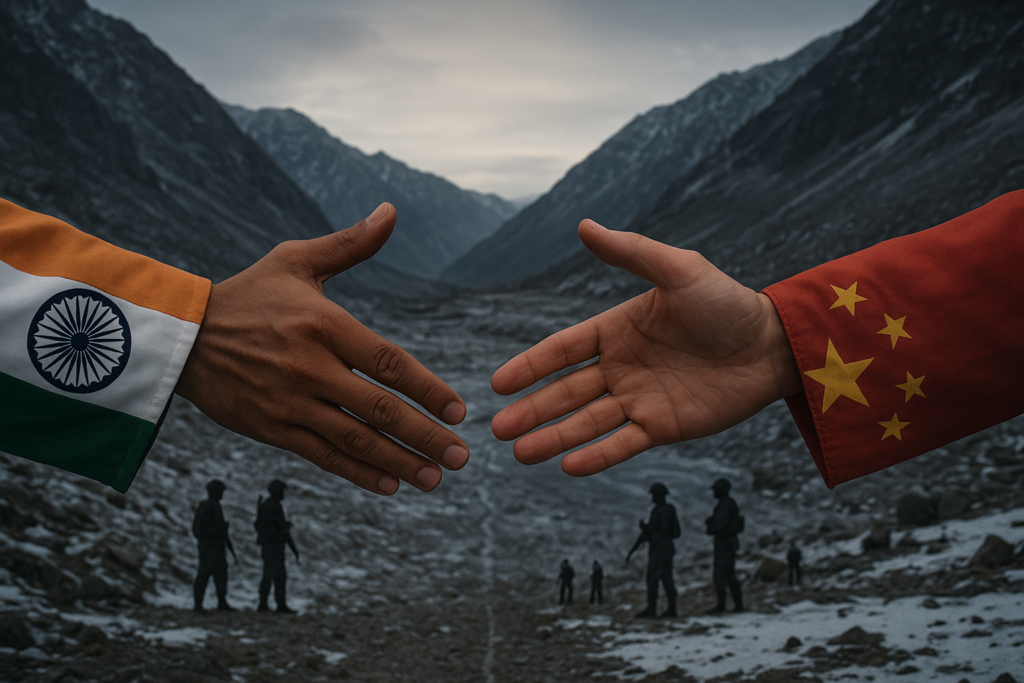
- India viewed China’s actions, the unilateral military mobilisation, the hostile aggression in Galwan Valley, and the violation of a long-standing understanding on border protocols as a betrayal.
- India’s demand for China to restore the status quo ante will be the litmus test of China’s intentions toward India.
- For India to engage in trade and cultural exchange while its border remains militarised would be a substantial strategic blunder—a perceived sign of weakness that would confirm Chinese aggression and legitimisation of territorial claims.
- The hard-earned lesson of Galwan is that trust can only be somewhat rebuilt through monitoring, preparedness, and sustained diplomatic resolve.
Trust and diplomacy have always been the pillars of successful international relations, but with India and China, the motto that has taken root has been “trust but verify.” The bilateral meeting between Indian Prime Minister Narendra Modi and Chinese President Xi Jinping, while a welcome step towards renewed engagement, did not erase the deep-rooted scepticism that has come to characterise the relationship between the two countries. The acute memory of the clashes in Galwan Valley in 2020, the ongoing military stalemate along the Line of Actual Control (LAC), and Beijing’s ambitions in the geopolitical sphere have forced New Delhi to learn a hard lesson: declarations of peace must always be weighed against actions on the ground.
The Source of Scepticism
The scepticism that pervades India’s posture toward China is not simply a diplomatic ploy; it is the direct result of a fundamental breach of trust. For decades, both nations had an unstated understanding that, as long as the border dispute remained unresolved, there would be peace and tranquillity along the LAC. That understanding was fractured in 2020. India viewed China’s actions — the unilateral military mobilisation, the hostile aggression in Galwan Valley, and the violation of a long-standing understanding on border protocols — as a betrayal. The skirmishes that led to fatalities on both sides were a turning point and catalysed India to move from its passive stance to take action and send an unequivocal signal. That included mobilising troops in large numbers along the border, banning multiple Chinese apps, and tightening foreign direct investment rules to eliminate opportunities for opportunistic acquisitions from the Chinese. This show of strength has characterised India’s diplomacy since, driving India’s approach to every move thereafter. New Delhi’s message was clear: a stable and de-escalated border is not an independent, but a prerequisite to normalisation.
A Fragile Thaw and Divergent Goals
The current situation in India-China relations may be termed a cautious détente, or a strategic pause marked by tactical de-escalation, rather than a meaningful reformulation of Beijing’s fundamental approach toward its neighbour. India has welcomed the recent engagement of Prime Minister Modi with President Xi Jinping, the limited public agreement for coordinated border patrols, and the return of some limited military and other commander-level dialogues as an important cooling-off period. However, New Delhi’s engagement will be seen as measured steps to address friction and stabilise the border, not as proceeding from a position of renewed and good faith with China. The reason for this cautious approach is rather significant: the goals of each country remain fundamentally different. India’s position constitutes a firm and non-negotiable offer: normalisation of the broader bilateral relationship will only occur with the troop disengagement and verifiable force de-escalation along the LAC, and all troops returning to their pre-April 2020 positions. India’s demand for China to restore the status quo ante will be the litmus test of China’s intentions toward India. These downgraded diplomatic relations, further disengagement, and contact will only happen when India asserts that the border is stable. Each side will remain cautious. In short, India sees the stabilisation of the border as a precondition for restoring complete political and economic engagement.
The acute memory of the clashes in Galwan Valley in 2020, the ongoing military stalemate along the Line of Actual Control (LAC), and Beijing's ambitions in the geopolitical sphere have forced New Delhi to learn a hard lesson: declarations of peace must always be weighed against actions on the ground.
China, on the other hand, continues to advocate for a compartmentalised approach. Beijing is trying to segregate the “transient” border issues from the “long-term” economic and political relationship. Its objective is to keep the military gains made in 2020 while also trying to revive trade, infrastructure investment, and multilateral diplomacy. This is exactly why India is significantly sceptical. New Delhi understands that without a stable, demilitarised border, any form of economic partnership or diplomatic manoeuvring is built on a questionable, unreliable foundation. China’s ongoing, significant infrastructure development in forward positions, including all-weather roads, storage depots, and troops, shows that while a military threat will always be there. For India to engage in trade and cultural exchange while its border remains militarised would be a substantial strategic blunder—a perceived sign of weakness that would confirm Chinese aggression and legitimisation of territorial claims. This is a strategic red line that India is not willing to cross. As a result, the high-level military discussions continue with a critical eye, and proposals for an “early harvest” package for border delimitation will be considered with utmost caution, as India’s military and foreign policy leadership will scrutinise every letter and every comma, to ensure that national security is not sacrificed for ostensible peace. The reassertion of military pressure, even while deploying diplomatic advances, reinforces the understanding in India that a process of verification—not reassurance—will lead the way forward.
The Long Game of Strategic Autonomy and Pragmatic Vigilance
Looking ahead, India-China relations will not be characterised by a single conciliatory meeting, but rather by a sustained, laborious and vexed process of strategic balancing and pragmatic vigilance. Indeed, India has a compass in its policy of strategic autonomy. This remains the sine qua non of its endeavours and means simply that India will interact with China on its own terms and will not simply accept a binary choice between Beijing and Washington. India is not simply taking sides in foreign policy terms but is trying to retain freedom of action for maximal interest promotion in an increasingly multipolar world. Hence, it is not only deepening security and technology partnerships with the Quad nations and other like-minded Western countries, but it continues to engage with China, as we see in wider multilateral forums like the BRICS and Shanghai Cooperation Organisation (SCO). These layers of engagement for India in no way contradict one another, but are a calculated and pragmatic way of utilising its growing geopolitical weight.
New Delhi's message was clear: a stable and de-escalated border is not an independent, but a prerequisite to normalisation.
India’s main challenge is to maintain its favourable rate of economic growth while responding to the associated security challenges. On the security side of the equation, India must be resolute—to ensure continued investment in border infrastructure, build military capacity, and adamantly resist efforts of territorial aggression—while more carefully and judiciously calculating India’s position on the economic side of things. It will require work to attract Chinese investment that can strictly comply with “Make in India” and “Aatmanirbhar Bharat” principles while also responding to the crippling trade deficits without seeming overly protectionist.
What the future of India-China relations will depend on is whether India can achieve the core duality of being a resolute defender of its sovereignty and security, while also remaining an open and sophisticated global economic actor. The hard-earned lesson of Galwan is that trust can only be somewhat rebuilt through monitoring, preparedness, and sustained diplomatic resolve. The mantra of “Trust but verify” is not just some epigram of diplomacy, but a necessary precondition to determine whether India will truly realise the opportunity to rebalance its relationship with a neighbour with deep-seated scepticism and risk endangering national security or India’s regional standing. It is a long game, demanding patience, resilience, and a clear-eyed understanding that the fundamental strategic rivalry will endure for the foreseeable future.
References:
- Mehrotra, Akshat. “India’s Tightrope Walk: Balancing the U.S.-China Rivalry.” IMPRI Impact and Policy Research Institute, May 4, 2025. https://www.impriindia.com/insights/indias-walk-balancing-us-china-rivalry/.
- Ellis-Petersen, Hannah. “Modi’s Warm Meeting with Xi Shows Impact of Trump’s ‘Tariff Tantrum’.” The Guardian, September 2, 2025. https://www.theguardian.com/world/2025/sep/02/putin-xi-modi-meet-message-to-west-trump-tariffs.
- Saran, Shyam. “Why India and China Remain Bitter Rivals.” TIME, September 10, 2025. https://time.com/7315783/india-china-remain-bitter-rivals/.
- Madan, Tanvi. “Has India Made Friends with China after the Modi-Xi Agreement?” The Brookings Institution, October 29, 2024. https://www.brookings.edu/articles/has-india-made-friends-with-china-after-the-modi-xi-agreement/.
- Sagar, Pradip R. “Four Years Since Galwan Valley Clash, How New Manoeuvres Deepen India-China Border Logjam.” India Today, June 13, 2024. https://www.indiatoday.in/india-today-insight/story/four-years-since-galwan-valley-clash-how-new-manoeuvres-deepen-india-china-border-logjam-2552774-2024-06-13.
- “India Between Superpowers: Strategic Autonomy in the Shadow of a Pacific Conflict.” Council on Foreign Relations. 2025. https://www.cfr.org/blog/india-between-superpowers-strategic-autonomy-shadow-pacific-conflict.
Hridbina Chatterjee is a final-year postgraduate student in International Relations at Jadavpur University, Kolkata. She has written for newspapers and think tanks, with interests in South Asian politics, India’s foreign policy, and the Indo-Pacific. Views expressed are the author’s own.
